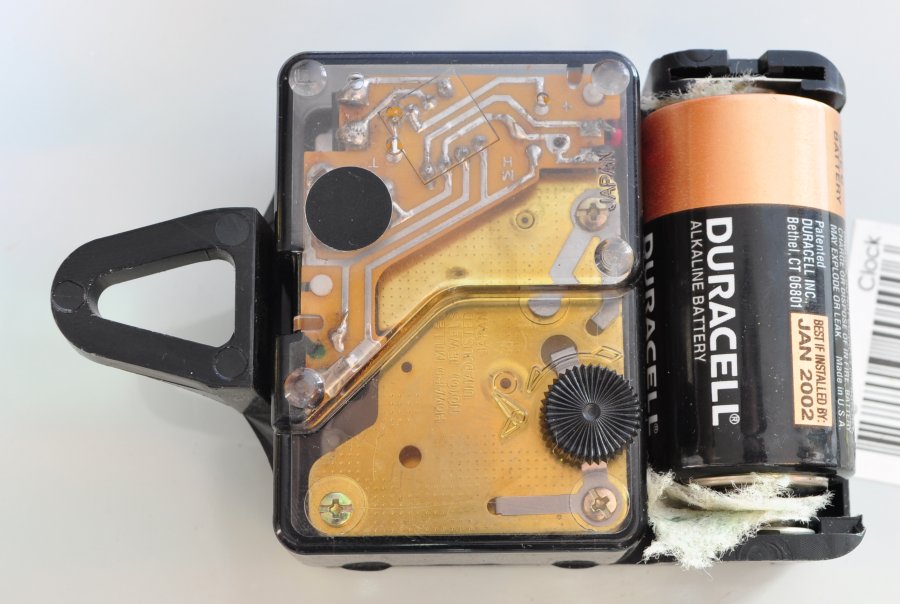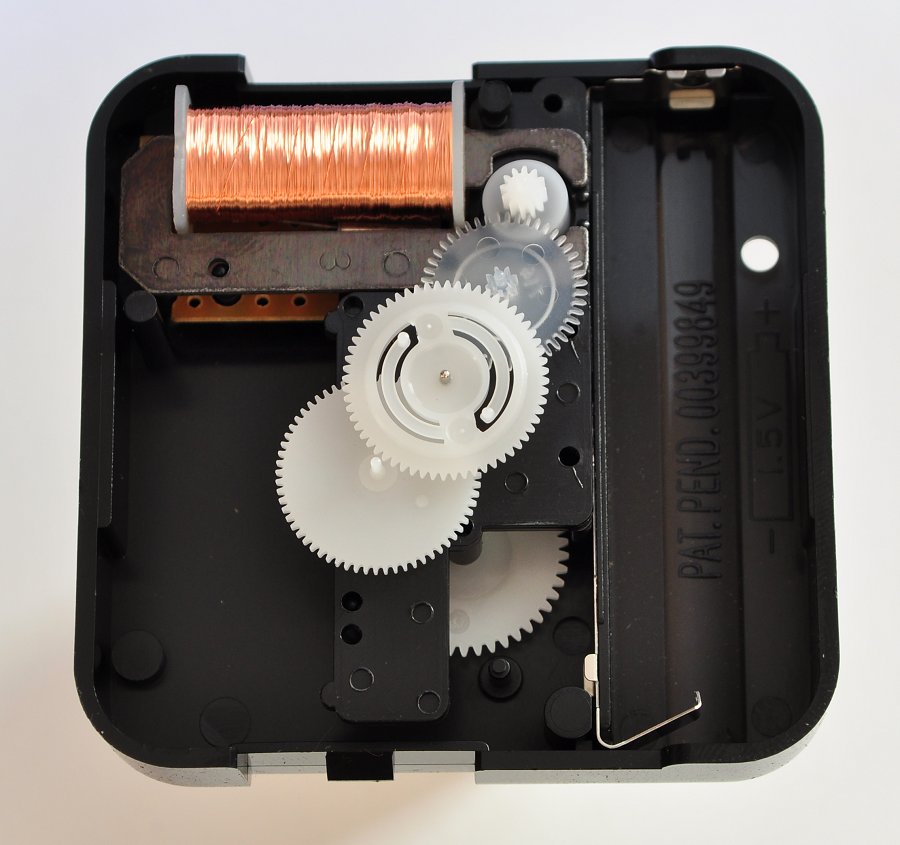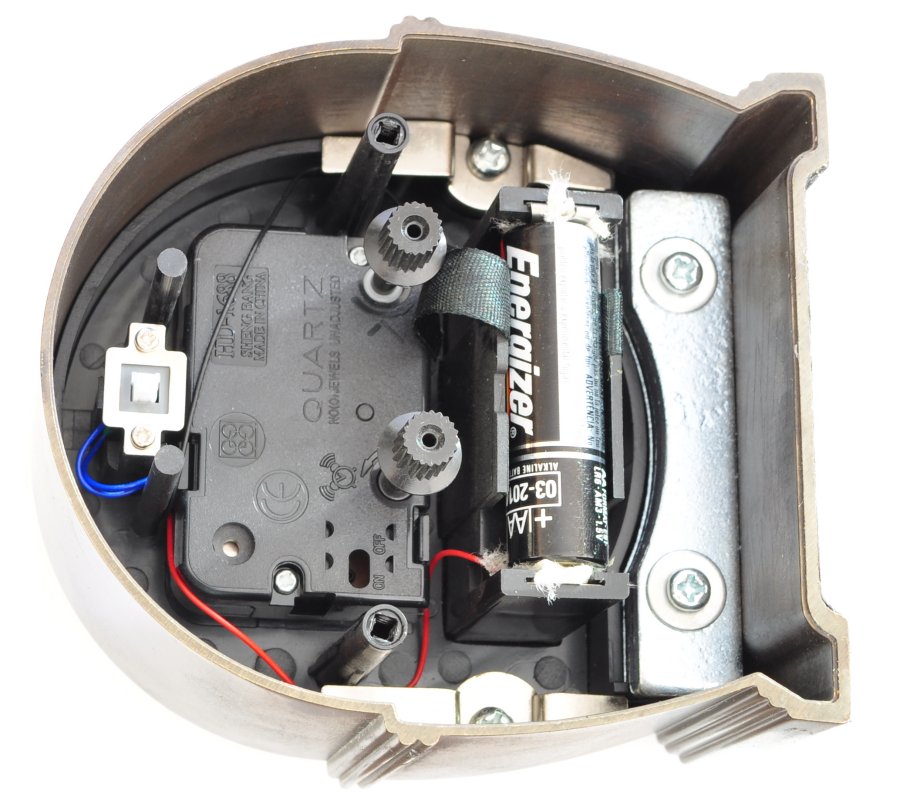Quartz Technology
Before the introduction of the Dollar Watch in about 1885, most people
had to depend on the sun for timekeeping. In towns, they could listen
to the church bells. Until then, clocks and watches were toys for those
who could afford them. Prices have gradually come down over time and,
in the last thirty years or so, quartz timepieces have been produced
that made it possible for everyone in society to own extremely accurate
and dependable timepieces for incredibly low prices. Watches can now be
bought new for less than the cost of having a watchmaker replace the
battery. Clocks are designed to run for a few years before they need to
be replaced, though some last for considerably longer. They are not
worth your time or expense to repair them, so I do not recommend
spending over $100 on any watch or clock with a quartz mechanism.
Quartz technology is fantastic. Below is a clock mechanism I found.
When I took the cover off, I found that it had stopped because it was
full of ants. Upon removal of the ants, it started running. It has been
running faithfully for me since 1989. I like the fact that it has brass
plates, so it must be relatively early, probably from around 1978. I add small
bits of tissue paper around the battery terminals in case the battery
leaks. The paper absorbs the battery acid and protects the clock's
circuit board. With a C battery, a clock like this will run for three
to five years.

|
Here is another mechanism of similar vintage, and also Japanese. You can see that the circuit board was soldered by hand.

|
The earliest quartz clock was made in the 1927, but it was too bulky
and costly and difficult to mass-produce. Quartz clocks and watches
were introduced for sale in 1969, when the technology to make
transistors into micro-processors and button-cell batteries were
developed. The following clock was made in the 1970s, judging by its circuit board,
and is the earliest example I have seen. It still runs perfectly in 2012. The
motor makes one revolution every six seconds, eliminating the need for
one more gear. The long tube on the left has the oscillating quartz
crystal. The micro-processor is barely visible in the photo, but it was
by far the most expensive component in this clock. Such
micro-processors would find their way into everything electronic, from
pocket calculators to microwave ovens to computers. My computer's
processor has 450 million transistors in about two square
inches, which shows how rapidly this technology has evolved in just forty years.

|
Newer quartz clocks are all plastic, almost. The advantages of plastic
are lower cost, no corrosion, less noise and less weight (so less power
required). The next clock is from Japan as well, circa 1995.
The second photo shows the micro-chip, but notice that there is no circuit board.

|

|
This mechanism is about as cheap as you can find. It is from 2003
and was made in Korea, though all the newer ones I see come from China.
 |
The simplest mechanisms, without chimes or alarms, are easy to take
apart. The motor makes one revolution every two seconds. Note the extra
(clear) gear.
 |
Here you see the contacts under the circuit board.
 |
This clock has one flaw. The surface that meets the contacts is very
thin. Over time, the surface wears a groove and, when the contact
fails, the clock becomes unreliable.
The micro-processor is under the black glob of tar. Next to it is the
long tube with the oscillating
quartz crystal.
 |
I added a small amount of solder to the surface where the contacts rub
to make the surface much thicker and more durable.
 |
Putting the mechanism back together was literally a snap. All quartz
clocks have this flaw, except those that have wires between the circuit
board and the battery terminals, like the clock in the first photo
above or the one below. Doing this repair and using tissue paper next
to the battery terminals will make this clock probably as durable as
the one with the brass plates.
 |
This little Chinese miracle was made to feel more substantial and
expensive by adding weight inside, but the quality is the cheapest that
pennies can produce. More weight does not mean better quality.
You can see that the circuit board is located near the positive
terminal of the battery, which is the most likely to leak. This assures
the destruction of the circuit board if the battery leaks. When that
happens, the manufacturer will be happy to sell you a new clock. I have
noticed the same self-destructive design feature in quartz watches, in
which there is no room for tissue paper.
Another issue to consider is battery life. Many digital clocks stop
working when the battery voltage falls to as low as 0.2 volts. Many
analog quartz clocks, however, fail at 1.2 volts. First, remove the
second hand, which, in most cases, is not needed anyway. You could also
remove the friction paws on the center wheel.
 |
 |
It is obvious that these quartz mechanisms are not worth the effort to
modify them like this because they are now so cheap. I did this one in
order to take photos for this
webpage, which made the effort worthwhile. The purpose of this webpage
was to show that quartz clocks are interesting, even if not
collectible.
Younger people today have no idea how expensive a clock of such
accuracy was as recently as 1965. By the way, the earliest Seiko quartz
watch cost as much in 1969 as a Toyota Corolla.
Escapements in Motion
Links Page
Tributes Page